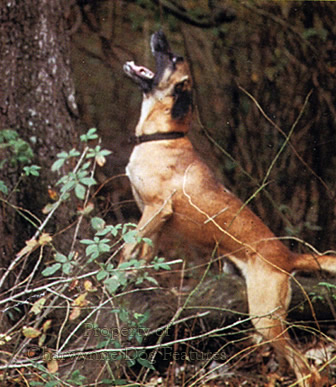911 BOBBERY PACKS - YANKEE STYLE
BOBBERY PACKS - YANKEE STYLE
by David Hancock


As Andreas F von Recum points out in his Hunting with Hounds in North America, (Pelican, 2002) settlers in America faced hunting challenges they had not found previously in European hunting grounds: “In North America, there are still large and aggressive predators to be hunted. They include mountain lion (also called cougar or puma), bobcat, Canadian lynx, brown bear, black bear, gray or timber wolf, red wolf and coyote. Some of this game had existed in Europe but has not been hunted for centuries. For this aggressive quarry the hound requires special agility, tenacity, and aggressiveness, called grit...Other game such as the raccoon and the opossum did not exist in Europe. Its pursuit requires a special hound not only with grit but that bays at the tree onto which the game has fled.” This led in time to the emergence of new types of hunting dog, designed to pursue or confront the new quarry.


It is hard to overstate the value of hunting dogs to settlers in America in past centuries, from conquistadors to colonists they needed food. And hounds aided their survival substantially. The hounds developed in the United States are largely unknown to hound fanciers in Britain. This is partly because they are mostly working types, not recognised by the American Kennel Club (AKC), but also because the distinctive hound breeds there have usually been under-rated by the working hound fraternity here. It is true too that American styles of hunting, allied with different quarry, saw the development of hounds with a quite different purpose from ours.


The Americans too use some of our breeds in the hunting field when we have long since failed to do so. Airedales, sometimes weighing up to 90lbs, have a hunting role there that perpetuates the sporting instincts of this admirable breed. In America too a much wider variation in hunting techniques was called for – with hounds to match. In his book Hunting Hounds of 1974, David Michael Duffy wrote: “Hounds that work raccoon are definitely tree hounds; those running lion, lynx, bobcat, and possibly bear would also normally be called tree hounds since the chase most frequently ends there. But dogs used on the other species – boar, deer, coyote, wolf and fox – would be trail hounds…From there we go into specifics. That gives us coonhounds, foxhounds, deerhounds, cathounds, bearhounds, boarhounds, and wolfhounds – if the hounds are ‘straight’ on these game species…” We could never match such variety of quarry in Britain. Our more restricted quarry, as well as smaller hunting fields, leave us with our Staghounds, Beagles, Harriers, Foxhounds and Otterhounds, with our Wolfhounds and Deerhounds having lost their historic role, despite the certainty of their chase against the marksmanship of the stalker, the tourist version especially.


The American packhounds are easily outnumbered by the ad hoc or 'bobbery' packs kept by families or individuals there, with the hounds bearing colourful names: Big 'n Blue (American Blue Gascon Hound), Black Mouth Cur, Bluetick Coonhound, Treeing Tennessee Brindle, Redbone Coonhound, Redtick Coonhound and the Plott Hound from the Great Smoky Mountains of Tennessee and North Carolina. The Black and Tan Coonhound and the American Foxhound are recognised breeds, with the latter having three strains in the South: the Walkers, the Triggs and the Julys or July-Birdsongs. All of these breed true to type, excel in the hunting field and perpetuate the blood of many European scenthound breeds, mainly French and English. From the Louisiana Bayou, the Ozark Mountains and other remote areas came French 'Staghounds' or Blue Gascons, with the Bluetick Coonhound claiming the blood of the French hound breed of Porcelaine. There are now six coonhound breeds recognized by the United Kennel Club (UKC) but only 1, the Black and Tan Coonhound by the AKC, their equivalent of our KC. There are also the Majestic Tree Hounds, a St Hubert type of Coonhound-Bloodhound mix, standing at around 28 inches and weighing over 100lbs, with their own association, formed in 1980.

The American 'staghound' is often just a different name for what we would call a lurcher, but they still use Borzois, Scottish Deerhounds and Greyhounds on the bigger game. American sportsmen too have never been afraid of 'custom-building' a type from different breeds to produce a hunting dog to suit their particular needs, as the 'tree-ing' specialist-dogs exemplify. They still use 'heavy-hounds too, as their own bigger stronger less-exaggerated Bulldogs described as Old English Whites, Georgia and Alapaha Bulldogs, as well as their American Bulldogs, demonstrate. Cattle-driving and cattle-pinning dogs are still a much-needed pastoral asset there, with pig-hunters utilising their gripping skills and immense tenacity too. I know of at least one rancher who uses the Fila Brasiliero as a cattle-dog, valuing their perseverance, a quality considered a fatal flaw by our DDA-imposing police 'experts'. We seem likely to lose, in the next decade or so, not just the capability to control wayward cattle but the dogs with the instincts to perform such dangerous work, not through any lack of need but through the ignorance of law-enforcers of the unique talents of such useful dogs. Such is progress!